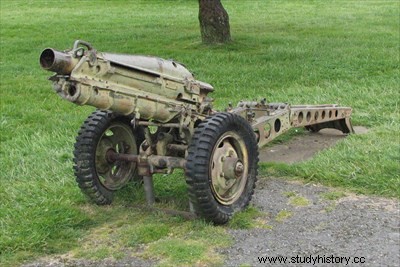
Features
M1A1
Caliber:75 mm.
Length:from the piece, 1.32 m;
of the barrel, 1.19 m.
Weight:complete, 587.900 kg.
Pointing in elevation:— 5° to + 45°.
Pointing in azimuth:6°.
Initial speed:maximum, 381m/s
Maximum range:8,925 m.
Projectile weight:6.241 kg.
In 1920, American military officials called for the creation of a lightweight 75 mm howitzer intended for combat in mountainous terrain.
These recommendations led in 1927 to the entry into service of the 75-mm Pack Howitzer M1, to which various subsequent modifications subsequently earned the new designation of M1A1. A mounting of ingenious design, which could be disassembled into six elements and whose arrow had been pierced with holes in order to reduce its weight, supported an equally decomposable weapon, with the barrel held in place in a trough by a cover placed at the top. , which gave the machine a particular look.
A screw mechanism installed on the axle allowed pointing in azimuth, the cradle therefore only comprising the pointing system in elevation.
The very first Ml were mounted on the Ml hide which, having to be pulled by draft animals, had wheels with wooden spokes. The mechanization of the units led to its replacement by the M8 lookout, with metal wheels with tires. The M1A1 was among the first artillery pieces issued to Allied airborne formations; the British also benefited. The M1 mounting, meanwhile, did not disappear:its manufacture continued throughout the Second World War, intended for certain partners of the United States, thus the Chinese army, which had a certain number of howitzers.
The M1A1, regardless of the mounting that supported it, was a great success with the troops and proved to be invaluable. Of very modern design, it was easy to use in operation, and could provide fire support up to a maximum distance of 8,925 m. Some conversions aimed at making it a self-propelled weapon (although it was of reduced weight), sometimes from half-tracked vehicles, were carried out and gave full satisfaction. Paradoxically, it is probably in mountainous terrain that the M1A1 was used the least often. The Allies, it is true, conducted few such campaigns, with the possible exception of Yugoslavia, where Tito's supporters became familiar with the craft under the direction of British officers. They made good use of it during the last moments of their liberation war.
The M1A1 will remain above all as the weapon of airborne formations. This was the case in Arnhem, where several specimens were deposited on the ground by General Aircraft Hamilcar gliders. It was also possible to dismantle it into nine bundles.
Without experiencing such a turbulent destiny, many howitzers of this type were simply used as fire support for the infantry, or as field artillery in the thick jungles of the Far East.
Their lightness allowed them to be used in the first phases of amphibious assaults such as that of Walcheren.
